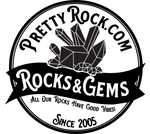Specific Gravity Instructions


Specific gravity (SG) is the density of a stone relative to the density of water. The specific gravity of water is one (1). If a stone has a SG is 3.95, then stone has a density that is 3.95 times greater than the density of water. SG is determined by dividing the stone's weight in air by the weight of the water is displaces when it is immersed in water. Because it does not require a polished surface, SG is one of the best tests for rough stones. You can perform the test in the field and with relatively inexpensive equipment.
The following directions are for the PrettyRock.com Specific Gravity Travel Kit. The kit fits stones up to about 50 ct or approximately 25 x 25 x 15mm and has reasonable accuracy up to .33 ct. You will need the kit, a calculator, and something to take notes on.
- There is no levitation or magic carpets involved. Instead it is called "weigh in air" to contrast it with the next step which is “weigh in water."
- Turn scale on and wait for the reading to go to zero. If it does not go to zero, press the tare button on the scale. Be sure the mode is set to carats.
- Put your clean and dry stone on the scale.
- Record the weight of the stone. We suggest you take each measurement 3 times and average your results.


Step 2: Weigh Stone in Water
- Make sure your stone is not water soluble such as halite!
- Start with the scale turn off. Place the clear shelf over the scale with the shelf's back edge lining up with the back edge of the circular depression on the scale's weighing platform.
- Slip the wire stand holder into the empty water cup. Place the base of the wire stand under the clear shelf, on the scale. The water cup should be on top of the clear shelf. Place the bowl on the wire stand (might not be needed for larger stones.)
- This is the fiddly bit. Arrange the wire stand so that it is not touching either the water cup or the clear shelf. You might need to angle either the wire stand or the water cup. Once you have done this a few times, you will be able to do this quickly.
- Carefully fill the water cup with water.
- Turn the scale on and wait for the reading to go to settle, then press tare to zero the reading. Check to see that the mode is set to carats.
- Gently place your stone on the holder in the water so that the stone is completely submerged and suspended. Tap away any air bubbles. Give the setup and the water some time to stop moving or shaking.
- Record the weight of the stone.
- We suggest you take each measurement 3 times and average your results.
Using the air weight and water weight of the stone, find the specific gravity using the following formula:
Compare your results with the specific gravity reference chart below.
Pro tips:
- Make sure your table is extremely stable! This is critical to getting an accurate reading. Trying to work on a shaky table or near something mechanical that vibrates (like an air conditioner!) can make getting a good reading impossible.
- Inclusions and impurities in the stone can affect the accuracy of the test.
- Use distilled water. Minerals in water can affect SG.
- Make sure your stone is clean. Grease can cause air bubbles to stick to your stone.
- Get the air weight first, and then the water weight to be sure the stone is dry.
- Avoid any extra friction. The wire stand and bowl must not be touching the water cup.
- Always perform at least three gemological tests when identifying a stone. No one test is conclusive.

